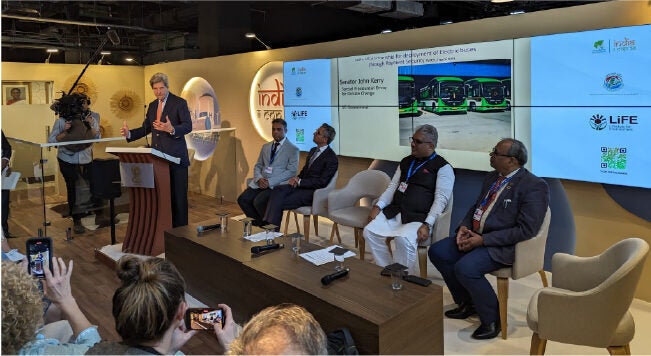COP28, South Asia and Fossil Fuels: Difficulties in Transition and Adaptation
Amitendu Palit
19 December 2023Summary
Transitioning to national fuel mixes comprising more renewables and less fossil fuels is yet to be a viable option for many countries. The outcomes of the Conference of the Parties to the UN Framework Convention on Climate Change highlight the difficulty for South Asia, along with concern over the lack of funds for aiding adaptation.
The 28th Conference of the Parties to the UN Framework Convention on Climate Change (COP28) concluded last week in Dubai after a fortnight’s hectic negotiations. Decisions from the meeting were awaited eagerly by all stakeholders. As dust settles on the occasion and the world absorbs the outcomes, it is time to reflect on what the summit delivered.
There was great interest in the success of COP28 in phasing out fossil fuels. The United Arab Emirates (UAE) Consensus eventually agreed to transition away from all fossil fuels to enable the world to reach the net-zero emissions target by 2050. While some would argue that the decision is an achievement, given that it has been endorsed by 195 countries, for many others, the decision is non-binding – and loosely worded – to reflect a decisive commitment. The difference between ‘transitioning away’, as mentioned in the UAE Consensus, and committing to giving up fossil fuels, is what marks the difference in views.
However, was a binding commitment on fossil fuels possible? For those harbouring such hopes, the expectations were rather high. Committing to specific timelines for phasing out fossil fuels – however necessary it is for pushing the world towards decarbonization – is an incredibly challenging goal for many countries. Nowhere is this more evident than in South Asia.
India, while highlighting its commitment to climate action, especially fulfilling the nationally determined contribution targets, also made it clear that it was unable to commit to giving up the use of coal. The high demand for energy in the Indian economy requires continuing reliance on fossil fuels for generating electricity. Nonetheless, during his address at COP28, India’s Prime Minister Narendra Modi emphasised the redoubling of efforts to transition from fossil fuels to renewables. The Indian position makes it abundantly clear that while encouraging renewables, giving up on fossil fuels is certainly not a viable economic option for it in the foreseeable future.
Global inequities in the abilities to adapt to climate change are perhaps the biggest obstacle to fighting the phenomenon as COP28 was again discovered. The South Asian region, including the populous economies of India, Pakistan and Bangladesh, as well as smaller economies like Sri Lanka and Nepal, are greatly handicapped in this regard. Moving to climate adaptation, particularly by phasing out fossil fuels, requires investing enormous funds in non-fossil options. India, for example, has been vigorously pursuing the development of wind and solar energy. However, even for an economy of its size, committing to phase out fossil fuels by a specific timeline, and transitioning to renewables, along with complying with various other adaptation measures, requires huge funds. These funds are nearly impossible to mobilise even if the Indian economy grows at unprecedented rates.
COP28 has made progress on adaptation. Notable among the adaptation achievements from the UAE Consensus are decisions to encourage countries to announce economy-wide nationally declared contributions for reducing emissions; tripling global production of renewables by 2030; and recognising the need for scaling up adaptation finance.
For the developing world, including the South Asian region, the operationalisation of the Loss & Damage Fund is a good beginning. However, it is disappointing that the early pledges for the Fund from some of the world’s wealthiest nations – the European Union, the United States, the UAE, the United Kingdom and Japan – together amount to only US$792 million (S$1.3 million) – far less than the US$100 billion (S$1.32 billion) that vulnerable developing countries require for fighting damages from climate change.
While COP28 did try to bring in binding decisions, two factors remain as outstanding obstacles in moving forward. The first is the marked difference among the states, as well as between businesses and civil society groups, on the pledge to cut out fossil fuels. The second is the lack of resources required to facilitate the transition to cleaner fuel and decarbonised industrial production.
Deep hesitations exist among several countries in their abilities to transition to renewables and phase out fossil fuels at the same time. This is evident from the differing perspectives within South Asia. Out of the 123 countries that pledged to triple global installed renewable energy production capacity by 2030, some South Asian countries were notable for their absence. These included India, Pakistan, Sri Lanka, Nepal and Afghanistan. For these countries, the choice of committing to expanding renewables cannot come at the expense of phasing down fossil fuels, at least not by 2030.
Among those developing countries and poor nations that have committed to ambitious transitions, the challenge is to access adequate financial resources. COP28 fell short of expectations in this regard. Till the international community is able to mobilise more funds, particularly from the rich nations, the goal of global decarbonisation through widespread transition will be difficult to achieve.
. . . . .
Dr Amitendu Palit is a Senior Research Fellow and Research Lead (Trade and Economics) at the Institute of South Asian Studies (ISAS), an autonomous research institute at the National University of Singapore (NUS). He can be contacted at isasap@nus.edu.sg. The author bears full responsibility for the facts cited and opinions expressed in this paper.
Pic Credit: SAREPEnergy Twitter Account
-
 More From :
More From :
-
 Tags :
Tags :
-
 Download PDF
Download PDF



